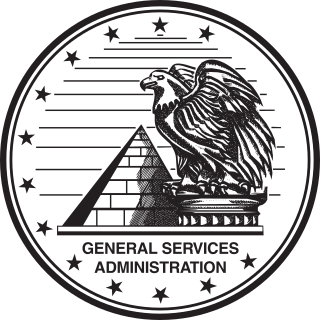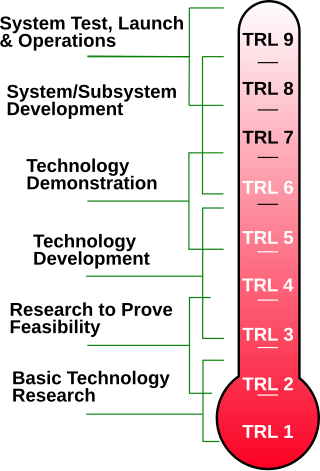Related Research Articles
The Lockheed Martin Corporation is an American aerospace and defense manufacturer with worldwide interests. It was formed by the merger of Lockheed Corporation with Martin Marietta in March 1995. It is headquartered in North Bethesda, Maryland, in the Washington, D.C. area. As of January 2022, Lockheed Martin employs approximately 115,000 employees worldwide, including about 60,000 engineers and scientists.

The Geostationary Operational Environmental Satellite (GOES), operated by the United States' National Oceanic and Atmospheric Administration (NOAA)'s National Environmental Satellite, Data, and Information Service division, supports weather forecasting, severe storm tracking, and meteorology research. Spacecraft and ground-based elements of the system work together to provide a continuous stream of environmental data. The National Weather Service (NWS) and the Meteorological Service of Canada use the GOES system for their North American weather monitoring and forecasting operations, and scientific researchers use the data to better understand land, atmosphere, ocean, and climate dynamics.

The Goddard Space Flight Center (GSFC) is a major NASA space research laboratory located approximately 6.5 miles (10.5 km) northeast of Washington, D.C. in Greenbelt, Maryland, United States. Established on May 1, 1959 as NASA's first space flight center, GSFC employs about 10,000 civil servants and contractors. Named for American rocket propulsion pioneer Robert H. Goddard, it is one of ten major NASA field centers. GSFC is partially within the former Goddard census-designated place; it has a Greenbelt mailing address.

The General Services Administration (GSA) is an independent agency of the United States government established in 1949 to help manage and support the basic functioning of federal agencies. GSA supplies products and communications for U.S. government offices, provides transportation and office space to federal employees, and develops government-wide cost-minimizing policies and other management tasks.

The U.S. Tracking and Data Relay Satellite System is a network of American communications satellites and ground stations used by NASA for space communications. The system was designed to replace an existing network of ground stations that had supported all of NASA's crewed flight missions. The prime design goal was to increase the time spacecraft were in communication with the ground and improve the amount of data that could be transferred. Many Tracking and Data Relay Satellites were launched in the 1980s and 1990s with the Space Shuttle and made use of the Inertial Upper Stage, a two-stage solid rocket booster developed for the shuttle. Other TDRS were launched by Atlas IIa and Atlas V rockets.

Darleen A. Druyun is a retired Senior Executive Service official of the United States Department of the Air Force and a former Boeing employee. In 2004, Druyun pleaded guilty to a felony in relation to her role in the United States Air Force tanker contract controversy, for engaging in corruption while serving as Principal Deputy Undersecretary of the Air Force for Acquisition.
E-procurement is a collective term used to refer to a range of technologies which can be used to automate the internal and external processes associated with procurement, strategic sourcing and purchasing.
The Federal Acquisition Regulation (FAR) is the principal set of rules regarding Government procurement in the United States, and is codified at Chapter 1 of Title 48 of the Code of Federal Regulations, 48 CFR 1. It covers many of the contracts issued by the US military and NASA, as well as US civilian federal agencies.
NAIS can mean:
In the United States, the processes of government procurement enable federal, state and local government bodies in the country to acquire goods, services, and interests in real property. Contracting with the federal government or with state and local public bodies enables interested businesses to become suppliers in these markets.
The NASA Space Science Data Coordinated Archive (NSSDCA) serves as the permanent archive for NASA space science mission data. "Space science" includes astronomy and astrophysics, solar and space plasma physics, and planetary and lunar science. As the permanent archive, NSSDCA teams with NASA's discipline-specific space science "active archives" which provide access to data to researchers and, in some cases, to the general public. NSSDCA also serves as NASA's permanent archive for space physics mission data. It provides access to several geophysical models and to data from some non-NASA mission data. NSSDCA was called the National Space Science Data Center (NSSDC) prior to March 2015.
The Capability Acquisition and Sustainment Group (CASG) is an organisation within the Australian Department of Defence, responsible for acquisition, supply chain management, and sustainment of military equipment and materiel including aircraft, ships, vehicles, electronic systems, weapons, ordnance, uniforms and rations for the Australian Defence Force. CASG employs more than 7000 military, civilian and contracted staff in more than 70 locations around Australia and internationally.
Military supply-chain management is a cross-functional approach to procuring, producing and delivering products and services for military materiel applications. Military supply chain management includes sub-suppliers, suppliers, internal information and funds flow.

The United Nations Department of Global Communications (DGC) is a department of the Secretariat of the United Nations. It is tasked with raising public awareness and support of the work of the United Nations through strategic communications campaigns, media and relationships with civil society groups.

Military acquisition or defense acquisition is the "bureaucratic management and procurement process", dealing with a nation's investments in the technologies, programs, and product support necessary to achieve its national security strategy and support its armed forces. Its objective is to acquire products that satisfy specified needs and provide measurable improvement to mission capability at a fair and reasonable price.
NASA's Solutions for Enterprise-Wide Procurement (SEWP) is a United States Government-Wide Acquisition Contract (GWAC) authorized by the U.S. Office of Management and Budget (OMB) and managed by the National Aeronautics and Space Administration (NASA).

The Top 100 Contractors Report is a list developed annually by the General Services Administration as part of its tracking of U.S. federal government procurement. It features the "Top 100" contractors with the U.S. government.

Technology readiness levels (TRLs) are a method for estimating the maturity of technologies during the acquisition phase of a program. TRLs enable consistent and uniform discussions of technical maturity across different types of technology. TRL is determined during a technology readiness assessment (TRA) that examines program concepts, technology requirements, and demonstrated technology capabilities. TRLs are based on a scale from 1 to 9 with 9 being the most mature technology.

The Gateway Logistics Services will be a series of uncrewed spaceflights to the Lunar Gateway space station, with the purpose of providing logistical services to the Gateway. Overseen by NASA's Gateway Logistics Element, the flights will be operated by commercial providers, contracted by the agency in support of crewed expeditions to the Gateway made under the Artemis program. As of March 2023, SpaceX is the only company contracted to provide the services.
References
- ↑ Crider, Ron (November 23, 2009). "NAIS Welcome Page". Archived from the original on May 11, 2009. Retrieved January 27, 2010.
- ↑ "Acquisition Reform: NASA's Internet Service Improves Access to Contracting Information". Archived from the original on 2012-02-27. Retrieved 2010-01-27.